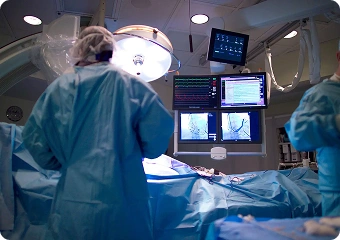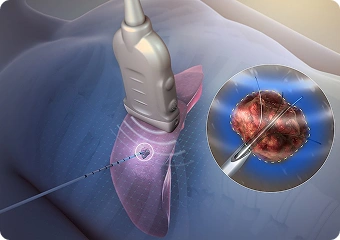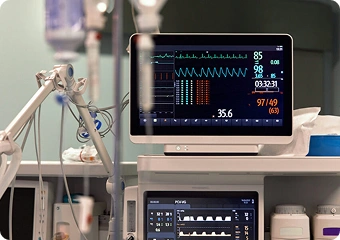
Electrophysiology Treatment: EPS & Radiofrequency Ablation (RFA)
Electrophysiology treatment includes Electrophysiology Study (EPS) and Radiofrequency Ablation (RFA), specialized techniques used to diagnose and correct abnormal heart rhythms or arrhythmias. Unlike standard ECG or echocardiography, which offer general electrical or structural information, EPS provides a detailed, real-time map of the heart’s electrical system. This allows for the identification of faulty circuits that cause irregular heartbeats. Once located, RFA uses targeted energy to destroy these abnormal pathways, restoring normal rhythm and preventing future arrhythmia episodes.
What Are Electrophysiology Studies (EPS)?
Electrophysiology Studies (EPS) are specialized diagnostic procedures that assess the heart’s electrical activity to identify the cause of arrhythmias. During EPS, thin catheters equipped with electrodes are inserted through blood vessels into the heart to record electrical signals and pinpoint abnormal conduction pathways. This detailed mapping helps detect conditions such as atrial fibrillation, supraventricular tachycardia (SVT), ventricular tachycardia, and other rhythm disorders.
EPS is typically recommended when patients experience unexplained fainting, palpitations, rapid heartbeat, or when non-invasive tests like ECG and Holter monitoring are inconclusive. It also helps determine the need for treatments such as pacemaker or defibrillator implantation, or guides further therapy like Radiofrequency Ablation (RFA) to correct the identified abnormal pathways.
What Are Radiofrequency Ablation (RFA)?
Radiofrequency Ablation (RFA) is a minimally invasive procedure used to treat abnormal heart rhythms or arrhythmias identified during an Electrophysiology Study (EPS). The process involves threading catheters through blood vessels into the heart to deliver controlled radiofrequency energy. This energy precisely targets and destroys small areas of heart tissue responsible for faulty electrical signals, thereby restoring normal rhythm.
RFA effectively treats conditions such as atrial fibrillation, atrial flutter, supraventricular tachycardia (SVT), and certain types of ventricular tachycardia. It is typically recommended when medications fail to control arrhythmias or when the arrhythmia source is mapped during EPS. RFA offers long-term symptom relief, reduces the need for lifelong medications, and lowers the risk of serious complications associated with untreated arrhythmias.
EPS & RFAStep-by-Step Process

Catheter Insertion
A thin, flexible catheter is inserted into a vein, usually in the groin area, and carefully guided through the blood vessels up to the heart.
Electrophysiology Study (EPS)
Once the catheter reaches the heart:
- An EPS is conducted to map the heart’s electrical activity.
- This test helps identify the source of any abnormal heart rhythms (arrhythmias).


Identifying Abnormal Pathways
- The mapping detects faulty electrical pathways that are causing irregular heartbeats.
- These areas are marked as targets for treatment.
Radiofrequency Ablation (RFA)
- If abnormal pathways are found, RFA is performed.
- Heat energy is delivered through the catheter tip to destroy the faulty tissue, correcting the heart rhythm.


Monitoring and Completion
- The procedure is done under local anesthesia.
- The patient’s heart is continuously monitored throughout to ensure accuracy and safety.
- Once rhythm is restored and confirmed stable, the catheters are removed.
Benefits of EPS & RFA Treatment
Accurate Diagnosis
Precisely identifies the source of abnormal electrical pathways causing arrhythmias.
Minimally Invasive Approach
Performed through small catheter insertions, ensuring faster recovery and minimal discomfort.
Improved Heart Rhythm Control
Effectively restores and maintains a normal heart rhythm, reducing symptoms.
Reduced Medication Dependence
Lessens the need for long-term use of antiarrhythmic drugs.
Lower Risk of Complications
Decreases the chance of stroke, heart failure, and other severe cardiac events.
Enhanced Quality of Life
Enables better exercise tolerance and daily functioning without arrhythmia-related limitations.
Why Choose Us for Electrophysiology?
Expert Electrophysiology Specialists
Led by highly qualified electrophysiologists with extensive training in diagnosing and treating complex arrhythmias.
State-of-the-Art EP Lab
Equipped with advanced Electrophysiology (EP) lab facilities featuring 3D mapping and real-time navigation systems for precise treatment.
Personalized Treatment Plans
Customized care strategies are designed according to individual heart rhythm disorders, ensuring safe and effective outcomes.
Excellent Clinical Outcomes
Proven success rates in arrhythmia control, symptom relief, and reduced recurrence after EPS and RFA procedures.
Comprehensive Follow-Up Care
Ongoing patient monitoring, regular assessments, and post-procedure guidance to ensure lasting heart rhythm stability.
Our Locations
Discover morefrequently asked questions
-
An electrophysiology study maps the heart’s electrical activity to detect irregular rhythms. In contrast, ablation is a therapeutic procedure that eliminates abnormal pathways causing arrhythmias. Both are often performed together for accurate diagnosis and treatment.
-
A cardiologist treats general heart diseases such as hypertension or coronary artery disease. An electrophysiologist specializes in diagnosing and managing heart rhythm disorders through procedures like EPS and RFA. They receive additional training in cardiac electrical systems.
-
Patients remain comfortable during the procedure due to local anesthesia and sedation. Mild pressure or discomfort at the catheter site may occur but resolves quickly after the procedure.
-
Electrophysiology is a minimally invasive catheter-based procedure, not open-heart surgery. It involves inserting thin wires into blood vessels to study the heart’s electrical activity. Recovery is generally quicker than traditional surgery.








